Tales of Attluma by David C. Smith: A Review and Oron Series Tour Guide
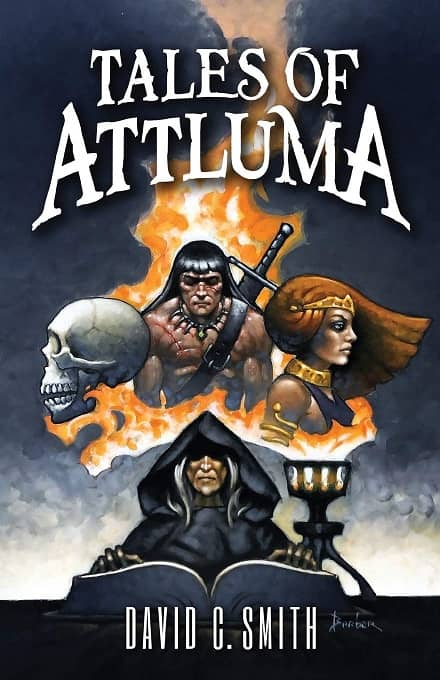 |
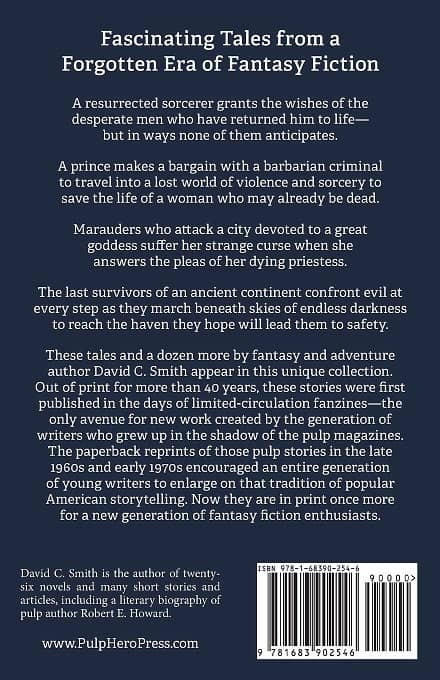 |
David C. Smith was the 2019 Guest of Honor at Howard Days 2019 for good reason, having written the acclaimed Robert E. Howard: A Literary Biography in 2018 to complement his decades of writing Sword & Sorcery (he has 26 novels written or co-written, including the Red Sonja series with Richard L. Tierney, the Oron and The Fall of the First World series, and more). He crafts his own flavor of adventure-horror with his Tales of Attluma (teased earlier at Black Gate), heavily influenced by Robert E. Howard (REH) and Clark Ashton Smith (CAS). Attluma is an island continent inspired by the mysterious Atlantis. These sixteen tales cover its cursed history and doomed end. Many entries were written in the 1970’s and are gathered now in one place for the first time.
The collection fits the Sword & Sorcery label, with an emphasis on Sorcery, specifically necromancy and demon summoning. These are fantastically dark and exciting stories, a true blend of REH’s action and CAS’s dreaded atmosphere. On Attluma, ancient gods live in mountain temples and underground. Humans struggle to survive on the surface and intrude on land made for, and by, demons. Excerpts are the best way to share the poetic, dark conflict readers should expect:
“Dressed in scarlet wounds and running with blood, here was my mother, her face beseeching mercy, gashes across her face and body. There came my father, hobbling on a split foot and one arm gone, strings of meat and tendon trembling from the open shoulder. Here was my brother, once a strong and handsome man, now in death a broken thing with no legs, pulling himself forward with his arms, his wife beside him, on her belly and kicking her feet as her head rolled beside her.” — from “The Last Words of Imatus Istum”
“And there was Yadis, The All Mother, the hag with one eye and triple teats whose spittle had made the stars and whose defecation made the earth. Her mad singing had awakened humans to life; we crawled from the muck and ever since wondered about the dark heart of life.” — from “Dark Goddess”
Interestingly, there are no Oron tales, Oron being the warrior protagonist (i.e., the heroic “Conan” of Attluma) that the original Zebra series was named after. Yet he is not needed here. Attluma is saturated with lore and conflict, armies of ghosts, lost loves seeking retribution, and hungry demons just looking for some attention. The last several stories ramp up the demonic uprising (or retaking) of the island continent. “The End of Days” finale is epic in scope, a sprawling battle with loads of mayhem and militant sorcery.
“Silene observed the sorcerers as they met and fought in the field. She saw the air turn colors between these people and watched as they moved their arms in gesticulations, or with daggers drew designs in the air. One or the other of these mysterious people would die, pulled into the sky to be torn invisibly into pieces, raining blood, or drawn into the earth to suffocate, or simply fall, breathless and unmoving, wrapped beneath sheets of glowing color.” — from “The End of Days”
Several of the attacking sorcerers made signs toward Edric’s fighters and dropped them. These men and women fell onto their backs and caught fire from their chests. They screamed as they died, but the unnatural fire consumed them swiftly, turning the men and women as black as charred wood. From the burnt corpses rose pieces of them, bits of black, which moved high into the air and, at the command of the attacking sorcerers, dropped like hurled missiles into the lines of Edric’s men, the bits of black pushing through faces and armor. …“Souls,” Hame told her. “They remove the charred souls from the burned bodies to use as weapons.” — from “The End of Days”
Attluma & Oron Tour Guide
Tales of Attluma is splendid by itself, but it serves as a foundation for the other works in the same world. Read this and you’ll want to jump into the novels and other short stories. A guide is needed since the publication history is complicated by title changes and, like most fantasy, publication order does not match the chronological order of the fictional world. Thanks to a group-read in the Goodreads Sword & Sorcery group we were able to communicate with David C. Smith and clarify the chronological & publication history of the Attluma Cycle (coined with the tacit approval of the author). As of 2020, there are 25 stories and novelettes, including those featuring Oron; 2 Oron novels; 1 Akram novel.
For newcomers, I recommend starting with Tales of Attluma since it fleshes out the world and prepares readers to jump into various arcs; arcs such as that of the featured barbarian Oron (many start with the 1978 book that introduced the character to the world named simply Oron), or the continuing curse of sorcerer Akram in The Sorcerer’s Shadow. To learn more about David C. Smith, check out recent interviews by DMR Books by David Ritzlin and on Black Gate with Joe Bonadonna. Note, this collection comes with an interview-format afterword that answers how these stories came about, why some stories were rewritten, and what the future holds for Attluma (there’s more to come).
Oron novels in Order of Narrative Timeline
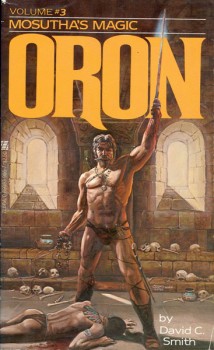 |
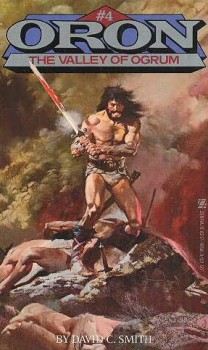 |
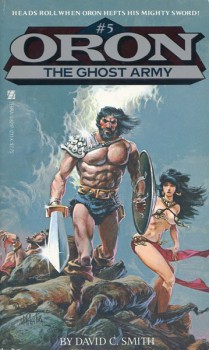 |
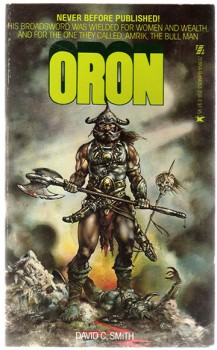 |
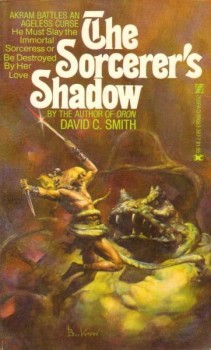 |
Attluma Cycle
Chronological Story-Order / Key Characters / Publication date
-
- Tales of Attluma: Collection containing sixteen stories with 2 Akram tales, 1 Dathien, and zero Oron, 2020 by Pulp Hero Press. Listed mostly in chronological order, mostly pre-Oron, with the last several being the end of Attluma (see below)
- “Shadow-born Shadow-taken” in Azieran Adventures Presents Artifacts and Relics: Extreme Sorcery: A pre-Oron novelette featuring Dathien from Tales of Attluma’s “Dark of Heart”, 2013
- “Twin Scars” in Warlords, Warlocks & Witches: A pre-Oron, standalone tale, 2019
- Oron: Mosutha’s Magic: Oron Novel 1/3, Zebra #3 1982 (original title: Reign, Sorcery!)
- Oron: The Valley of Ogrum: Oron Novel 2/3, Zebra’s #4 1982 (original title: Deathwolf)
- Oron: The Ghost Army: Five short stories with Oron, Zebra #5, 1983 (original title: Death in Asakad and Other Stories)
- “The Shadow of Dia-Sust” Oron short story appears in The Mighty Warriors, 2018 (also available online at Black Gate)
- Oron: the original Oron Novel 3/3, Zebra #1, 1978
- Sometime Lofty Towers, Pulp Hero Press 2021
- The Sorcerer’s Shadow: Akram Novel, Zebra #2, 1982 (original title: The Shadow of Sorcery)
- Engor’s Sword Arm: A novella, Forgotten Ages ~1991
- Several stories from Tales of Attluma including two Akram tales (“Come Death” and “The Return to Hell”) and the grand finale “The End of Days”
Tales of Attluma Contents & Summaries
…with possible spoilers
1. “Descales’ Skull”: Three men collect as many parts of Descales’ skull and resurrect his soul. He grants them each a wish (excess gold, power over slavery, partnering with a woman). All get their wish and nasty, ironic deaths.
2. “The Generosity of the Gods”: Obroc of Kurstikan and his buddy Cedes are fishermen who decide to test the power of the two gods (they should remain nameless!). The pair blaspheme to determine if the gods are real. The consequences are so terrifying, so very terrible, but at least the friends survive in some way, together. This is so dark, it is funny.
3. “Feasting Shadows”: Pel and Jenta are a young couple seeking ancient temples in the caves, and come across more than ruined ritual spaces. They experience the Song, Dance, and Culmination of the Feast.
4. “Dark of Heart”: Captain Dathien gets a second chance of freedom. Princess Amyra is missing in Midriga (his place of origin) and Prince Eam seeks to save her. What ensues is a mad mission into the mountainous region of Midriga, involving body horror, bleak fates for all.
5. “The Last Words of Imatus Istum”: The depressing story of Imatus Kad Istum, hailing from the civilized city Mograd, which was overrun by the barbaric Kunashtu. Loss of knowledge, slavery, eating of former citizens, raising the dead on a mass scale.
6. “Aliastra the Sorceress”: Count Holos, a homeless roaming royal who deals with failing his family; he had been taught that ‘he owned his own future through the choices/actions he made’. This is mostly a story of the love between the sorceress Aliastra and her long-dead lover Ormenidu, which Holos gets embroiled in.
7. “Ithtidzik”: The titular student was arrogant enough to seek power from around his wise mentor; he seeks out an ancient tome from a demon…and gains more insight than his single head can hold! Sharing knowledge with enthralled, sustained corpses helps for a time. This doesn’t end well for the protagonist, of course.
8. “Rhasjud’s Destiny”: A mercenary warlord of the title returns to the site of where he murdered his brother, who haunts him; wolves and ghosts roam everywhere.
9. “Blood Ransom”: Androm, the pretty boy, gets tied up with Tsathsimus and Ishrid in a plot to kidnap the princess Asri. Beware bloody red gems that are actually alive. Asri and Lady Liprosa appreciate redemption and this benefits Androm.
10. “Dark Goddess”: Jutom and the Nathgali warriors ransack the city of Coroth, which includes the raping of a priestess of Yasid. The product of rape and torture will haunt Jutom.
11. “Come, Death”: Akram is introduced as a cursed immortal sorcerer strolling through plagued ruins. He pities a child amongst a plague and saves it.
12. “The Return to Hell”: Akram appears again in a very trippy story. Akram amasses mercenaries to sacrifice them to the Witch/Sorcerer pair (Nidyis, Narathkor) that made him immortal. He wishes to die, but he has a young female fan Tharis who wants to be like him. He tries to spare her even as he leads hundreds to slaughter.
13. “The Passing of the Sorcerer”: A love story of the sorcerer Camses with royal princess Porissa of Karhum, with hints of reincarnation and celestial life. A demonic scourge plagues the town and the King. Apparently, humans took too much from the demons without sacrifice or honor, or sufficient belief.
14. “Patience Serves”: A dose of vengeance for a “wronged love” between Lady Tristania and Lord Mors.
15. “The Sounding of the Gong”: Another bizarre love story. Seft and Oma (sorcerer aged, and younger sorceress) are the last few humans worth stealing from. A trap is set for these thieves to sacrifice. This continues the theme of weird-love and eternal life between pairs of sorcerers.
16. “The End of Days”: Meet the poet Nour, his pregnant wife Silene, and her brother Edric, as they race toward the Surkad Capital city. It is the last stand for humans on Attluma. The demon Serenthal seeks to reclaim all the territory and eliminate everything. It is over the top epic and dark. A great end to the book (and series).
David C. Smith:
David C. Smith was born on August 10, 1952, in Youngstown, Ohio. In addition to many essays and short stories, he is the author or co-author of 26 published novels, primarily in the sword-and-sorcery, horror, and suspense genres. Ten of his novels from the 1970s and 1980s are now being revised to be republished. The epic trilogy The Fall of the First World will be followed by Magicians and The Eyes of Night—two modern occult novels featuring the sorcerer David Trevisan—and five sword-and-sorcery novels featuring the character Oron. Pulp Hero Press will also be releasing Dave’s latest sword-and-sorcery novel, Sometime Lofty Towers, later this year.
In addition, Smith coauthored the screenplay Magicians (with Joe Bonadonna, author of Mad Shadows and Three Against the Stars), based on the David Trevisan novels.
Smith is also the author of the postsecondary English grammar textbook Understanding English: How Sentences Work.
Aside from writing fiction, Smith has worked as an advertising copyeditor and English teacher and for more than twenty years as a scholarly medical editor. He has served on the staff of Neurology, was the editorial production manager of the American Journal of Ophthalmology, and for sixteen years as the managing editor of the Journal of the American Academy of Orthopaedic Surgeons. He is now retired and works as a freelance editor.
Smith, his wife, Janine, and their daughter, Lily, live in Palatine, Illinois, outside Chicago.
Further information about David C. Smith and his writing is available in his entry on Wikipedia
S.E. Lindberg resides near Cincinnati, Ohio working as a microscopist by day. Two decades of practicing chemistry, combined with a passion for the Sword & Sorcery genre, spurs him to write adventure fictionalizing the alchemical humors (under the banner Dyscrasia Fiction). With Perseid Press, he writes weird tales in the same vein (Heroika and Heroes in Hell series). He co-moderates the Sword & Sorcery group on Goodreads, and invites all to participate. He enjoys studying Aikido and creates all sorts of fine art in the family workshop. Touch base via Facebook or Twitter.

Excellent review of a most excellent collection of sword and sorcery tales, Seth. I have the honor of bragging rights: I read some of these stories in early or final draft form. I’m very happy they have finally been published in one fine volume. Great job, Dave!!!
Joe, you pirate! Thanks. I threatened David that I may take a road trip to IL one day (post-Covid-chaos) and grab some signatures from you two (with a copy of Waters of Darkness).
Tales of Attluma really blew me away. It seems darker than his novels. Super glad Pulp Hero Press published this set. Also thrilled he engaged so many readers in the GR group. He rocks. And more Attluma tales are brewing it seems….
Seth – my bad. I forgot to thank you for the honorable mention! So . . . thank you!
I just bought this and I’m loving it. I plan to savor it slowly, the same way I read CAS collections. Bravo!
@John R. Fultz, given your own passion for CAS, sorcerers, and weird adventure, this seems right up your alley.
March 2021 update… I added Pulp Hero Press’s “Sometime Lofty Towers” release to the chronology (now #9 in the list above between “Oron” and “The Sorcerer’s Shadow”)